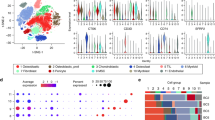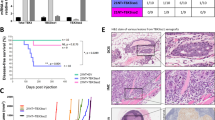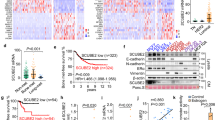Abstract
In malignant tumors, metastasis genes are typically deregulated by aberrant expression or splicing. Osteopontin is expressed at high levels by various cancers and contributes importantly to their invasive potential. In contrast, osteopontin derived from host cells induces cellular immunity and could bolster antitumor protection by cytotoxic T lymphocytes. Here we show that breast cancer cells express multiple splice variants of osteopontin. According to RT–PCR analysis of human breast tissue specimens, the splice variant osteopontin-c is a highly specific marker for transformed cells, which is not expressed in their surrounding normal tissue. The full-length form of osteopontin aggregates in the presence of physiologic amounts of calcium and, in this state, leads to enhanced cell adhesion. Ostensibly, this effect is inhibitory for tumor cell dissemination. The shortest splice variant, osteopontin-c, does not aggregate in the presence of calcium and enhances clone formation in soft agar. According to microarray analysis, osteopontin-c induces the expression of oxidoreductases, consistent with protection from anoikis during anchorage-independent growth. These studies define a third functional domain of osteopontin, beside the C-terminal CD44-binding site and the central integrin-binding site. They also provide evidence for a bifunctional character of osteopontin, with the soluble form supporting invasiveness and the aggregated form promoting adhesion.
This is a preview of subscription content, access via your institution
Access options
Subscribe to this journal
Receive 50 print issues and online access
$259.00 per year
only $5.18 per issue
Buy this article
- Purchase on Springer Link
- Instant access to full article PDF
Prices may be subject to local taxes which are calculated during checkout





Similar content being viewed by others
References
Adler B, Ashkar S, Cantor H, Weber GF . (2001). Cell Immunol 210: 30–40.
Ashkar S, Weber GF, Panoutsakopoulou V, Sanchirico ME, Janssen M, Zawaideh S et al. (2000). Science 287: 860–864.
Barraclough R, Chen HJ, Davies BR, Davies MP, Ke Y, Lloyd BH et al. (1998). Biochem Soc Symp 63: 273–294.
Bayless KJ, Meininger GA, Scholtz JM, Davis GE . (1998). J Cell Sci 111: 1165–1174.
Behrend EI, Chambers AF, Wilson SM, Denhardt DT . (1993). J Biol Chem 268: 11172–11175.
Benjamini Y, Hochberg Y . (1995). J Roy Stat Soc B 57: 289–399.
Chackalaparampil I, Banerjee D, Poirier Y, Mukherjee BB . (1985). J Virol 53: 841–850.
Chen H, Ke Y, Oates AJ, Barraclough R, Rudland PS . (1997). Oncogene 14: 1581–1588.
Chen PW, Geer DC, Podack ER, Ksander BR . (1996). Ann NY Acad Sci 795: 325–327.
Crawford HC, Matrisian LM, Liaw L . (1998). Cancer Res 58: 5206–5215.
Denhardt DT, Lopez CA, Rollo EE, Hwang SM, An XR, Walther SE . (1995). Ann NY Acad Sci 760: 127–142.
El-Tanani M, Barraclough R, Wilkinson MC, Rudland PS . (2001a). Cancer Res 61: 5619–5629.
El-Tanani M, Barraclough R, Wilkinson MC, Rudland PS . (2001b). Oncogene 20: 1793–1797.
Goldsmith HL, Labrosse JM, McIntosh FA, Maenpaa PH, Kaartinen MT, McKee MD . (2002). Ann Biomed Eng 30: 840–850.
Gunthert U, Hofmann M, Rudy W, Reber S, Zoller M, Haussmann I et al. (1991). Cell 65: 13–24.
Guo J, Sartor M, Karyala S, Medvedovic M, Kann S, Puga A et al. (2004). Toxicol Appl Pharmacol 194: 79–89.
He B, Weber GF . (2003). Eur J Biochem 270: 2174–2185.
Hosack DA, Dennis Jr G, Sherman BT, Lane HC, Lempicki RA . (2003). Genome Biol 4: R70.
Hwang SM, Lopez CA, Heck DE, Gardner CR, Laskin DL, Laskin JD et al. (1994). J Biol Chem 269: 711–715.
Kasugai S, Zhang Q, Overall CM, Wrana JL, Butler WT, Sodek J . (1991). Bone Miner 13: 235–250.
Karyala S, Guo J, Sartor M, Medvedovic M, Kann S, Puga A et al. (2003). Cardiovasc Toxicol 4: 47–73.
Kiefer MC, Bauer DM, Barr PJ . (1989). Nucl Acids Res 17: 3306.
Kon S, Maeda M, Segawa T, Hagiwara Y, Horikoshi Y, Chikuma S et al. (2000). J Cell Biochem 77: 487–498.
Matsumura Y, Tarin D . (1992). Lancet 340: 1053–1058.
Oates AJ, Barraclough R, Rudland PS . (1996). Oncogene 13: 97–104.
O'Regan AW, Hayden JM, Berman JS . (2000). J Leukoc Biol 68: 495–502.
Reiner A, Yekutieli D, Benjamini Y . (2003). Bioinformatics 19: 368–375.
Rittling SR, Chen Y, Feng F, Wu Y . (2002). J Biol Chem 277: 9175–9182.
Rittling SR, Feng F . (1998). Biochem Biophys Res Commun 250: 287–292.
Rudland PS, Platt-Higgins A, El-Tanani M, De Silva Rudland S, Barraclough R, Winstanley JH, Howitt R, West CR . (2002). Cancer Res 62: 3417–3427.
Saitoh Y, Kuratsu J, Takeshima H, Yamamoto S, Ushio Y . (1995). Lab Invest 72: 55–63.
Sartor M, Schwanekamp J, Halbleib D, Mohamed I, Karyala S, Medvedovic M et al. (2004). Biotechniques 36: 790–796.
Seraj MJ, Samant RS, Verderame MF, Welch DR . (2000). Cancer Res 60: 2764–2769.
Singhal H, Bautista DS, Tonkin KS, O'Malley FP, Tuck AB, Chambers AF et al. (1997). Clin Cancer Res 3: 605–611.
Sung V, Gilles C, Murray A, Clarke R, Aaron AD, Azumi N et al. (1998). Exp Cell Res 241: 273–284.
Tanabe KK, Stamenkovic I, Cutler M, Takahashi K . (1995). Ann Surg 222: 493–501.
Tuck AB, Arsenault DM, O'Malley FP, Hota C, Ling MC, Wilson SM et al. (1999). Oncogene 18: 4237–4246.
Urquidi V, Sloan D, Kawai K, Agarwal D, Woodman AC, Tarin D et al. (2002). Clin Cancer Res 8: 61–74.
Weber GF, Adler B, Ashkar S . (1999). Inflammatory Cells and Mediators in CNS Diseases In: Ruffolo Jr RR, Feuerstein GZ, Hunter AJ, Poste G, Metcalf BW (eds). Harwood Academic Publishers: Amsterdam, pp. 97–112.
Weber GF, Abromson-Leeman S, Cantor H . (1995). Immunity 2: 363–372.
Weber GF, Ashkar S . (2000a). J Mol Med 78: 404–408.
Weber GF, Ashkar S . (2000b). Brain Res Bull 53: 421–424.
Weber GF, Ashkar S, Glimcher MJ, Cantor H . (1996). Science 271: 509–512.
Weber GF, Zawaideh S, Kumar VA, Glimcher MJ, Cantor H, Ashkar S . (2002). J Leukoc Biol 72: 752–761.
Yokosaki Y, Matsuura N, Sasaki T, Murakami I, Schneider H, Higashiyama S et al. (1999). J Biol Chem 274: 36328–36334.
Young MF, Kerr JM, Termine JD, Wewer UM, Wang MG, McBride OW et al. (1990). Genomics 7: 491–502.
Zhang G, He B, Weber GF . (2003). Mol Cell Biol 23: 6507–6519.
Zitvogel L, Couderc B, Mayordomo JI, Robbins PD, Lotze MT, Storkus WJ . (1996). Ann NY Acad Sci 795: 284–293.
Acknowledgements
This study was supported by National Institutes of Health research Grant CA76176 and Department of Defense breast cancer Grant DAMD17-02-0510 to GFW. The collection of tumor specimens was supported in part by USPHS Grant #M01 RR 08084 from the General Clinical Research Centers Program, National Center for Research Resources, NIH. Dr Danny Welch, Birmingham, AL, generously provided the MDA-MB-435 cells.
Author information
Authors and Affiliations
Corresponding author
Additional information
Supplementary Information accompanies the paper on Oncogene website (http://www.nature.com/onc)
Supplementary information
Rights and permissions
About this article
Cite this article
He, B., Mirza, M. & Weber, G. An osteopontin splice variant induces anchorage independence in human breast cancer cells. Oncogene 25, 2192–2202 (2006). https://doi.org/10.1038/sj.onc.1209248
Received:
Revised:
Accepted:
Published:
Issue Date:
DOI: https://doi.org/10.1038/sj.onc.1209248
Keywords
This article is cited by
-
Anoikis resistance––protagonists of breast cancer cells survive and metastasize after ECM detachment
Cell Communication and Signaling (2023)
-
Meta-analysis of Osteopontin splice variants in cancer
BMC Cancer (2023)
-
Extracellular matrix remodeling in tumor progression and immune escape: from mechanisms to treatments
Molecular Cancer (2023)
-
Autophagy inhibition prevents lymphatic malformation progression to lymphangiosarcoma by decreasing osteopontin and Stat3 signaling
Nature Communications (2023)
-
CRISPR/Cas9 mediated knocking out of OPN gene enhances radiosensitivity in MDA-MB-231 breast cancer cell line
Journal of Cancer Research and Clinical Oncology (2023)



